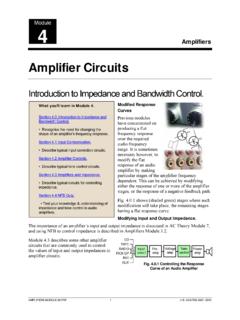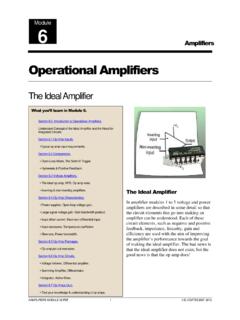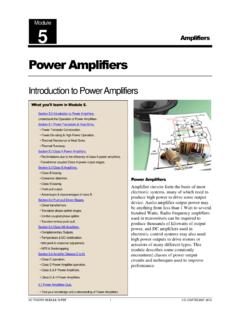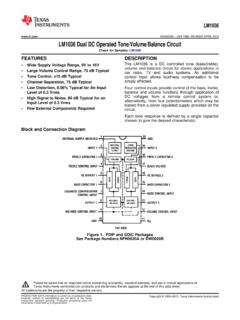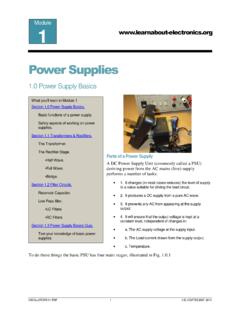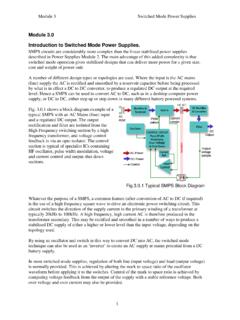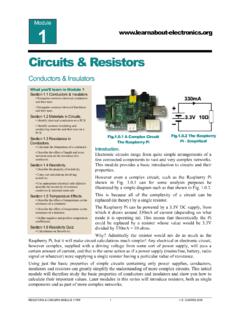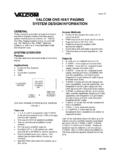Transcription of Amplifiers - Learn About Electronics
1 Module 1 Amplifiers Amplifiers Introduction to Amplifiers What you'll Learn in Module 1. Section amplifier Basics. Typical functions of Amplifiers in electronic systems. Graphical representations of Amplifiers . amplifier applications and types of signal. Section amplifier Parameters. Typical amplifier parameters. Gain, Frequency response, Bandwidth, Input and Output impedance, Phase shift, Feedback. Section Class A Biasing. An amplifier is used to increase the amplitude of a BJT Common emitter and FET common source signal waveform, without changing other biasing.
2 Parameters of the waveform such as frequency or Emitter, DC and temperature stabilisation. wave shape. They are one of the most commonly used circuits in Electronics and perform a variety of Class A bias. functions in a great many electronic systems. Common emitter input and output characteristics. The general symbol for an amplifier is shown in Section Gain and Decibels. Fig The symbol gives no detail of the type of amplifier described, but the direction of signal flow Amplification. can be assumed (as flowing from left to right of the Logarithmic scales.)
3 Diagram). Amplifiers of different types are also often described in system or block diagrams by Specifying voltage and power using dBs. name. Common dB values. Section Bandwidth. Typical Response curves. Factors affecting bandwidth. Section amplifier Basics Quiz. Test your knowledge of Amplifiers Fig amplifier general symbol, used in system diagrams Amplifiers 1 E. COATES 2007 -2012. Amplifiers Module 1. For example look at the block diagram of an analogue TV receiver in Fig and see how many of the individual stages (shaded green) that make up the TV are Amplifiers .
4 Also notice that the names indicate the type of amplifier used. In some cases the blocks shown are true Amplifiers and in others, the amplifier has extra components to modify the basic amplifier design for a special purpose. This method of using relatively simple, individual electronic circuits as "building blocks". to create large complex circuits is common to all electronic systems; even computers and microprocessors are made up of millions of logic gates, which are simply specialised types of Amplifiers . Therefore to recognise and understand basic circuits such as Amplifiers is an essential step in learning About Electronics .
5 Fig Analogue TV receiver block diagram, showing Amplifiers used in many stages. One way to describe an amplifier is by the type of signal it is designed to amplify. This usually refers to a band of frequencies that the amplifier will handle, or in some cases, the function that they perform within an electronic system. Amplifiers Audio frequency Amplifiers are used to amplify signals in the range of human hearing, approximately 20Hz to 20kHz, although some Hi-Fi audio Amplifiers extend this range up to around 100kHz, whilst other audio Amplifiers may restrict the high frequency limit to 15kHz or less.
6 Voltage Amplifiers are used to amplify the low level signals from microphones, tape and disk pickups etc. With extra circuitry they also perform functions such as tone correction equalisation of signal levels and mixing from different inputs, they generally have high voltage gain and medium to high output resistance. Power Amplifiers are used to receive the amplified input from a series of voltage Amplifiers , and then provide sufficient power to drive loudspeakers. Amplifiers Intermediate Frequency Amplifiers are tuned Amplifiers used in radio, TV and radar.
7 Their purpose is to provide the majority of the voltage amplification of a radio, TV or radar signal, before the audio or video information carried by the signal is separated (demodulated) from the radio signal. Amplifiers MODULE 2 E. COATES 2007 -2012. Amplifiers Module 1. They operate at a frequency lower than that of the received radio signal, but higher than the audio or video signals eventually produced by the system. The frequency at which Amplifiers operate and the bandwidth of the amplifier depends on the type of equipment.
8 For example, in AM radio receivers the Amplifiers operate at around 470kHz and their bandwidth is normally 10kHz (465. kHz to 475kHz), while TV commonly uses 6 Mhz bandwidth for the signal at around 30 to 40 MHz, and in radar a band width of 10 MHz may be used. Amplifiers Radio Frequency Amplifiers are tuned Amplifiers in which the frequency of operation is governed by a tuned circuit. This circuit may or may not, be adjustable depending on the purpose of the amplifier . Bandwidth also depends on use and may be relatively wide, or narrow.
9 Input resistance is generally low, as is gain. (Some RF Amplifiers have little or no gain at all but are primarily a buffer between a receiving antenna and later circuitry to prevent any high level unwanted signals from the receiver circuits reaching the antenna, where it could be re-transmitted as interference). A special feature of RF Amplifiers where they are used in the earliest stages of a receiver is low noise performance. It is important that background noise generally produced by any electronic device, is kept to a minimum because the amplifier will be handling very low amplitude signals from the antenna ( V or smaller).
10 For this reason it is common to see low noise FET transistors used in these stages. Fig. FM Radio using AF, IF and RF Amplifiers . Ultrasonic Amplifiers Ultrasonic Amplifiers are a type of audio amplifier handling frequencies from around 20kHz up to About 100kHz; they are usually designed for specific purposes such as ultrasonic cleaning, metal fatigue detection, ultrasound scanning, remote control systems etc. Each type will operate over a fairly narrow band of frequencies within the ultrasonic range. Wideband Amplifiers Wideband Amplifiers must have a constant gain from DC to several tens of MHz.
